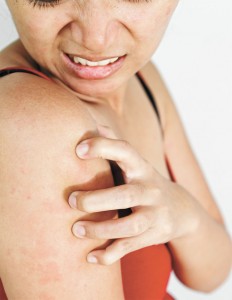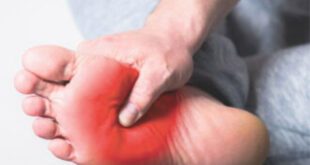By Dr. James M. Davenport, F-AAA, CCC-A –
 People from all walks of life and all ages live with eczema; however, it typically appears in infants. Also called contact dermatitis, eczema is actually a group of skin conditions. Although it may sometimes look like a contagious condition, eczema is not contagious.
People from all walks of life and all ages live with eczema; however, it typically appears in infants. Also called contact dermatitis, eczema is actually a group of skin conditions. Although it may sometimes look like a contagious condition, eczema is not contagious.
Specifically, contact dermatitis is a condition in which the skin becomes red, sore, or inflamed after direct contact with a substance. There are two kinds of contact dermatitis: irritant or allergic.
Irritant dermatitis is the most common type. It’s caused by contact with acids, alkaline materials such as soaps and detergents, fabric softeners, solvents, or other chemicals. The immediate reaction usually looks like a burn. Other irritants that can cause reactions include: cement, hair dyes, pesticides, and long-term exposure to wet diapers.
Allergic contact dermatitis is more severe and is caused by exposure to a substance or material to which you have become extra sensitive or allergic.
Common allergens include:
- Adhesives, including those used for false eyelashes or toupees
- Antibiotics such as neomycin rubbed on the surface of the skin
- Balsam of Peru (used in many personal products and cosmetics, as well as in many foods and drinks)
- Fabrics and clothing
- Fragrances in perfumes, cosmetics, soaps, and moisturizers
- Nail polish, hair dyes, and permanent wave solutions
- Nickel or other metals (found in jewelry, watch straps, metal zips, bra hooks, buttons, pocketknives, lipstick holders, and powder compacts)
- Poison ivy, poison oak, poison sumac, and other plants
- Rubber or latex gloves or shoes
Although you may not have a reaction to a substance when you are first exposed to it, regular use can eventually cause sensitivity and a reaction to the product.
Some products cause a reaction only when the skin is also exposed to sunlight (photosensitivity). These include shaving lotions, sunscreens, sulfa ointments, some perfumes, coal tar products, and oil from the skin of a lime. A few airborne allergens, such as ragweed or insecticide spray, can cause contact dermatitis as well.
SYMPTOMS
Symptoms vary depending on the cause and whether the dermatitis is due to an allergic reaction or an irritant. The same person may also have different symptoms over time.
Allergic reactions may occur suddenly, or it may take months of being exposed to a substance for a reaction to develop.
The hands are a common site for contact dermatitis to appear. Hair products, cosmetics, and perfumes often lead to skin reactions on the face, head, and neck. Jewelry can also cause reactions in the area under it.
Itching of the skin in exposed areas is a common symptom. In the case of an allergic dermatitis, itching can be severe. Dermatitis caused by an irritant may also cause a painful burning sensation.
Allergic dermatitis often causes a red, streaky, or patchy rash where the substance touched the skin. The allergic reaction is often delayed, with the rash appearing 24 – 48 hours after exposure. The rash may:
- Have red bumps that may form moist, weeping blisters
- Feel warm and tender
- Ooze, drain, or crust
- Become scaly, raw, or thickened
Irritant dermatitis often shows as dry, red, and rough skin. Cuts (fissures) may form on the hands. Skin may become inflamed with long-term exposure to the irritant.
PATCH TESTING
The diagnosis is mostly based on the skin appearance and a history of exposure to an irritant or an allergen.
Allergy testing with skin patches (called patch testing) may determine which allergen is causing the reaction. Patch testing is used for certain patients who have long-term, repeated contact dermatitis. It requires three office visits and must be done by a provider with the experience and skill to interpret the results correctly.
- On the first visit, small patches of possible allergens are applied to the skin. These patches are removed 48 hours later to see if a reaction has occurred.
- A third visit about 2 days later is done to look for any delayed reaction.
- If you have already tested a material on a small area of your skin and noticed a reaction, you should bring the material with you.
Other tests may be used to rule out other possible causes, including skin lesion biopsy or culture of the skin lesion (see skin or mucosal biopsy culture).
TREATMENT
Treatment includes washing with lots of water to remove any traces of the irritant that may remain on the skin. You should do your best to avoid further exposure to any known irritants or allergens.
In some cases, the best treatment is to do nothing to the area. Other times topical lotions and creams might be used to relive the symptoms. Emollients or moisturizers help keep the skin moist, and also help skin repair itself. They protect the skin from becoming inflamed again. They are a key part of preventing and treating contact dermatitis. Corticosteroid skin creams or ointments may reduce inflammation. Carefully follow the instructions when using these creams. Overuse, even of low-strength over-the-counter products, may cause a skin condition. Wet dressings and soothing anti-itch (antipruritic) or drying lotions may be recommended to reduce other symptoms.
In severe cases, corticosteroid pills may be needed. You will start them on a high dose, which is tapered gradually over about 12 days. You may also receive a corticosteroid shot.
It is important to call your health care provider if you have symptoms of contact dermatitis, especially if you have a severe reaction and if there is no improvement after treatment.
*source: A.D.A.M. Medical Encyclopedia
Allergy & Asthma Care of Florida
352-622-1126
 Central Florida Health and Wellness Magazine Health and Wellness Articles of the Villages
Central Florida Health and Wellness Magazine Health and Wellness Articles of the Villages



